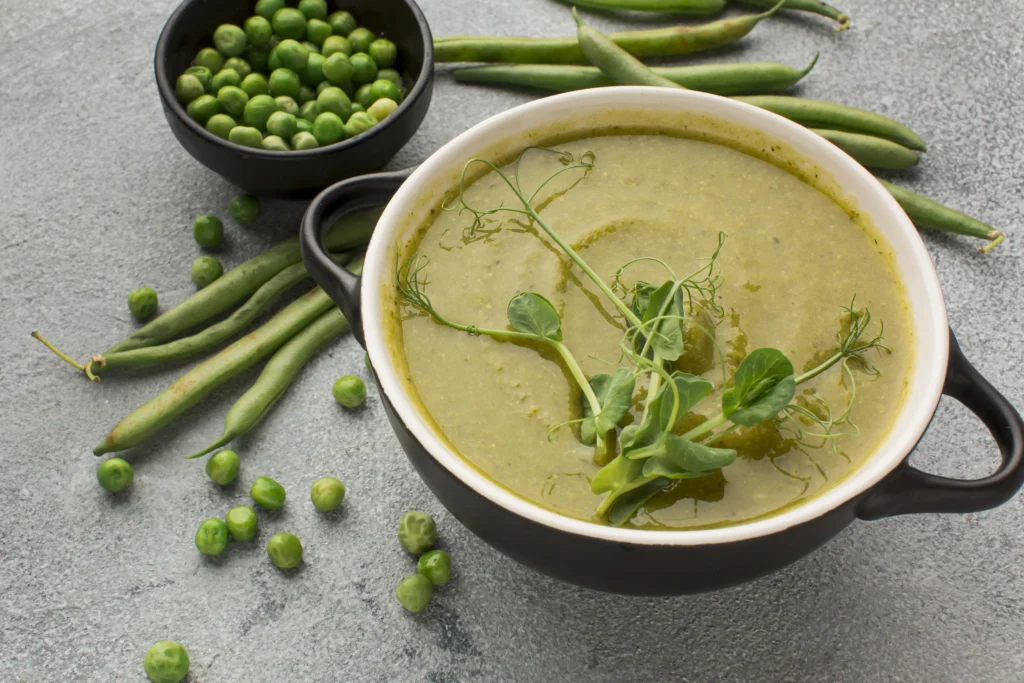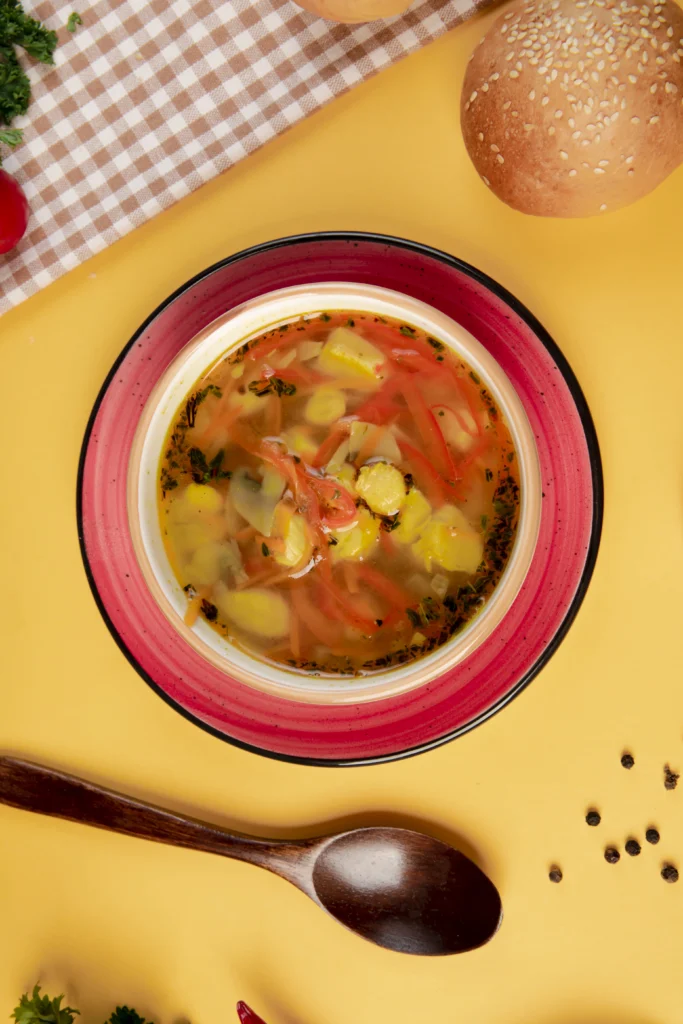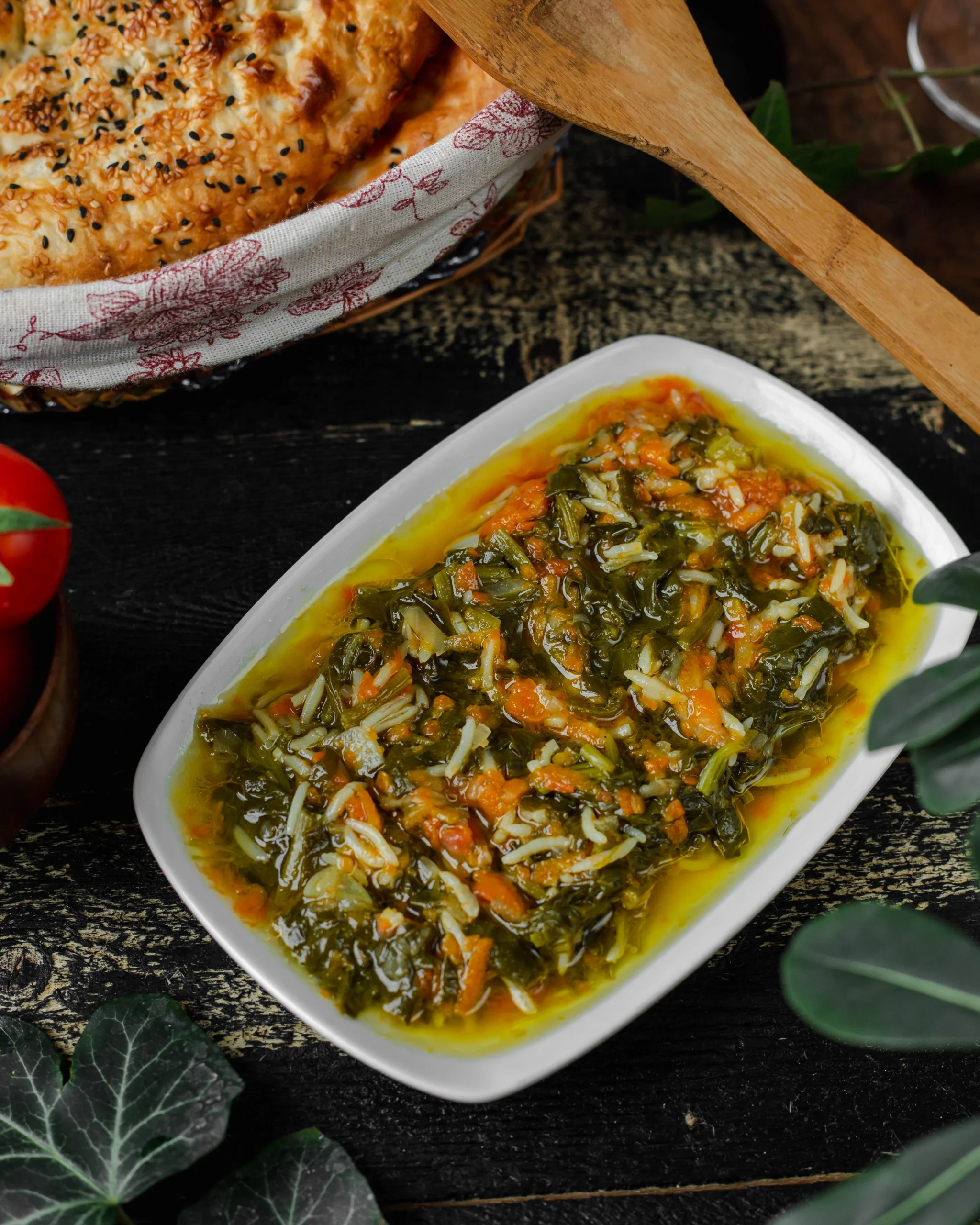Green gumbo, or gumbo z’herbes, is a traditional Louisiana dish deeply rooted in Creole culture and often enjoyed during Lent, especially on Holy Thursday. Unlike classic gumbo, which features seafood or meat prominently, this hearty variation puts the spotlight on leafy greens—a flavorful blend that might include collards, mustard greens, turnip greens, kale, spinach, parsley, and more.
What sets gumbo z’herbes apart isn’t just its rich, earthy flavor, but also the symbolic folklore behind it. According to tradition, the number of greens used should be odd, and for every green you add, you’ll gain a new friend in the coming year—a beautiful blend of culinary art and superstition.
Though originally prepared as a meatless dish for Lent, modern recipes often incorporate ham hocks and andouille sausage for added depth. Whether vegetarian or meaty, green gumbo remains a soulful, nourishing, and flexible dish with a fascinating cultural legacy.
Table of Contents
A Brief History of Gumbo Z’herbes
Gumbo z’herbes, often called “green gumbo,” is a dish that reflects the cultural melting pot of Louisiana, combining influences from West African, French, Spanish, and Native American cuisines. Its roots trace back to “potage aux herbes”, a French-style herb soup, which evolved in the New World with the abundance of native greens and Creole cooking traditions.
Traditionally served on Holy Thursday before Easter, gumbo z’herbes was originally a vegetarian Lenten meal, though over time many cooks began adding meats like smoked ham, andouille sausage, and beef brisket to enhance the flavor—particularly when the dish was served for large family gatherings.
Creole cooks believed in using seven or more types of greens, and sometimes up to thirteen. According to legend, each type of green would bless you with a new friend in the coming year. More than just a meal, gumbo z’herbes became a symbol of community, celebration, and cultural resilience.

Essential Ingredients in Green Gumbo
Green gumbo (gumbo z’herbes) is defined by its rich combination of leafy greens and deeply layered flavors. While recipes vary, several core ingredients are essential to achieving its signature texture and taste.
1. Leafy Greens
The heart of the dish is its greens—traditionally an odd number of types for good luck. Common choices include:
- Collard greens
- Mustard greens
- Turnip greens
- Kale
- Spinach
- Parsley
- Green onions
These are simmered down into a velvety, earthy base that gives the gumbo its distinctive identity.
2. The Cajun Trinity
No Creole gumbo is complete without the “trinity”:
- Onion
- Bell pepper
- Celery
These are usually sautéed in a dark roux, which adds depth and body to the stew.
3. Proteins (Optional but Traditional)
While green gumbo was originally meatless, many versions include:
- Smoked ham hocks
- Andouille sausage
- Salt pork or brisket
These meats add smokiness and richness to the broth.
4. Seasonings and Thickeners
- Bay leaves, thyme, black pepper, and Cajun spices
- File powder (ground sassafras leaves) added at the end as a thickener and flavor enhancer
With this foundation, green gumbo becomes a powerful expression of flavor, heritage, and nourishment.
How to Make a Roux for Green Gumbo
The roux is the soul of many gumbos, and green gumbo is no exception. A properly made roux adds richness, color, and complexity to the dish. It’s created by slowly cooking equal parts fat and flour until it reaches the desired shade—usually medium to dark brown for gumbo z’herbes.
1. Ingredients & Tools
- ½ cup flour
- ½ cup oil (traditionally peanut or vegetable oil)
- A heavy-bottomed pot and constant attention
2. Cooking Process
Heat the oil over medium heat, then slowly whisk in the flour. Stir constantly for 15–30 minutes, adjusting heat as needed to avoid burning. The roux should smell nutty and develop a chocolatey color.
3. Tips for Success
- Never walk away from a roux—it burns quickly
- If it smells scorched, start over
- Stir with a flat wooden spoon or silicone spatula for even browning
Once ready, the roux becomes the flavorful base for sautéing the “Cajun trinity” and building your gumbo.
Step-by-Step Cooking Instructions
Making green gumbo is a labor of love that rewards patience with deep, soulful flavor. Follow these steps to build a traditional and delicious gumbo z’herbes:
1. Prepare the Greens
- Wash and chop 7 or more varieties of leafy greens (collards, kale, mustard, spinach, parsley, etc.).
- Optionally blanch tougher greens (like collards or turnip greens) for 2–3 minutes to soften.
2. Make the Roux
- In a large, heavy pot, heat ½ cup oil over medium heat.
- Add ½ cup flour and stir constantly for 20–30 minutes until the roux is deep brown (chocolate-colored).
- Be careful not to burn it—lower the heat if needed.
3. Sauté the Cajun Trinity
- Add chopped onion, bell pepper, and celery (about 1 cup each) directly into the hot roux.
- Cook until vegetables are soft and the mixture is aromatic (5–7 minutes).
4. Add Garlic, Seasonings, and Stock
- Stir in 4 cloves minced garlic, bay leaves, thyme, black pepper, and Cajun seasoning to taste.
- Slowly pour in 6–8 cups of warm chicken or vegetable stock, stirring constantly to prevent lumps.
5. Add Meats (Optional)
- Add smoked ham hocks, andouille sausage, or salt pork at this stage.
- Simmer for 45–60 minutes, allowing the meat to flavor the broth.
- Remove large meat cuts, shred, and return to the pot.
6. Add the Greens
- Gradually stir in all the greens. Don’t worry if it looks like too much—they’ll wilt quickly.
- Simmer uncovered for another 30–45 minutes, stirring occasionally, until the greens are tender and the gumbo has thickened.
7. Finish and Adjust
- Stir in file powder (about 1 tsp) at the end, if using.
- Taste and adjust salt, pepper, or spice as needed.
8. Serve Hot
- Ladle over warm white rice and garnish with green onions or hot sauce, if desired.
Popular Variations and Dietary Adaptations
While traditional green gumbo (gumbo z’herbes) is rooted in Creole heritage, it’s a recipe that invites personalization. Over the years, many cooks have developed delicious variations to suit dietary needs and modern tastes.
1. Vegetarian & Vegan Versions
Historically, gumbo z’herbes was meatless—perfect for Lent. To make a flavorful vegan version:
- Skip the meat and use vegetable stock.
- Add depth with smoked paprika, liquid smoke, or miso paste.
- For protein, include white beans, mushrooms, or tofu sausage.
2. Gluten-Free Adaptation
- Instead of a flour-based roux, use gluten-free flour (like rice flour or a 1:1 GF blend).
- Or skip the roux and thicken the gumbo naturally with pureed greens or okra.
3. Adding Okra or Beans
While not traditional in green gumbo, okra can add natural thickness and a subtle earthiness. Beans like navy, red, or lima provide a creamy texture and boost the nutrition profile.
4. Meatless but Smoky
If you want that smoked flavor without meat, consider:
- Smoked salt
- Charred onions or peppers
- Roasted tomatoes
With so many ways to tweak the recipe, green gumbo becomes not just a meal—but a canvas for creativity that still honors tradition.

How to Serve Green Gumbo
Green gumbo is a comforting, hearty dish that’s best enjoyed hot and fresh, typically served over a generous scoop of steamed white rice. The rice balances the earthiness of the greens and absorbs the flavorful broth, making every bite rich and satisfying.
For a more traditional Southern touch, some serve it with buttermilk cornbread, hush puppies, or even a side of hot sauce for extra kick. A dash of file powder (ground sassafras) sprinkled over the bowl just before serving adds a subtle, sweet-woodsy note and further thickens the gumbo.
In large gatherings—especially on Holy Thursday in Louisiana—green gumbo is served as the main course, often alongside other Southern staples like sweet tea, collard greens, or fried catfish.
Don’t forget the garnishes: chopped green onions, a squeeze of lemon juice, or a few crushed red pepper flakes can all add brightness and contrast to this deep, soulful dish.
Storage, Reheating, and Freezing Tips
One of the best things about green gumbo is that it tastes even better the next day as the flavors continue to deepen. Proper storage ensures you can enjoy leftovers safely and deliciously.
Refrigeration:
Allow the gumbo to cool completely, then transfer it to an airtight container. Store in the refrigerator for up to 4–5 days. Reheat gently over medium-low heat, stirring occasionally to prevent sticking or separating.
Freezing:
Green gumbo freezes well! Portion it into freezer-safe containers or bags (leaving some room for expansion) and freeze for up to 3 months. For best results, avoid freezing rice—add fresh rice when reheating.
Reheating Tips:
- Thaw overnight in the fridge for best texture
- Reheat on the stovetop to preserve flavor and consistency
- Stir gently to avoid breaking down the greens or roux
Green gumbo is a perfect make-ahead meal that only improves with time—ideal for meal prep or sharing.
Nutrition Overview and Health Benefits of the Greens
Green gumbo isn’t just flavorful—it’s packed with nutrients. With its rich blend of leafy greens, this dish delivers a powerhouse of vitamins, minerals, and fiber, making it as nourishing as it is satisfying.
Key Nutritional Benefits:
- High in Vitamins A, C, and K – Supports immune health, vision, and blood clotting.
- Rich in Iron and Calcium – Important for energy production and bone health.
- Excellent source of fiber – Promotes digestion and helps regulate blood sugar.
- Antioxidants & anti-inflammatory compounds – Found in greens like kale, parsley, and spinach.
Even with added proteins or roux, green gumbo remains a balanced meal—especially if served with whole grain rice. It’s naturally low in sugar and cholesterol, and with smart ingredient choices (e.g., plant-based broth, olive oil), it can easily fit into vegetarian, vegan, or heart-healthy diets.
In short, it’s comfort food with real benefits—deeply soulful and deeply nourishing.
Frequently Asked Questions (FAQs)
1. What is gumbo green?
“Gumbo green” refers to gumbo z’herbes, a traditional Louisiana Creole stew made primarily with leafy greens. Unlike the more well-known versions of gumbo that feature seafood or chicken and sausage, green gumbo focuses on a medley of greens—such as collards, mustard, turnip, spinach, and parsley—often cooked with or without meat. It’s commonly associated with Lenten traditions and is especially popular on Holy Thursday.
2. What are the 2 rules of gumbo?
Though every cook has their own method, two golden rules of gumbo are:
a. Never burn the roux. A scorched roux ruins the base flavor of the dish.
b. Never rush the simmer. Gumbo should be cooked low and slow to build rich, deep flavor and let the ingredients fully develop.
3. What are the three types of gumbo?
Traditionally, gumbo is categorized into three main types:
- Seafood gumbo: Often with shrimp, crab, and oysters.
- Chicken and sausage gumbo: Made with smoked andouille and poultry.
- Gumbo z’herbes (green gumbo): Based on greens and often meatless, though some versions include smoked meats.
4. What is a traditional gumbo made of?
Traditional gumbo typically includes:
- A roux (flour and fat cooked together)
- The “Cajun trinity” (onion, bell pepper, and celery)
- A protein (seafood, chicken, sausage, or greens)
- Spices, stock, and sometimes file powder or okra for thickening
Each version reflects the cultural and regional diversity of Creole and Cajun cuisine.
Conclusion: Why You Should Try Making Green Gumbo
Green gumbo, or gumbo z’herbes, is more than a comforting, hearty stew—it’s a taste of Louisiana history and culture in a single bowl. With its deep flavors, nutritious ingredients, and adaptability for different diets, it’s a dish that welcomes tradition while leaving room for creativity.
Whether you’re observing Lent, exploring Southern cuisine, or just looking for a new way to enjoy leafy greens, this gumbo is a rewarding kitchen project. Prepare a big pot, share it with loved ones, and enjoy a soulful meal that gets even better the next day.

